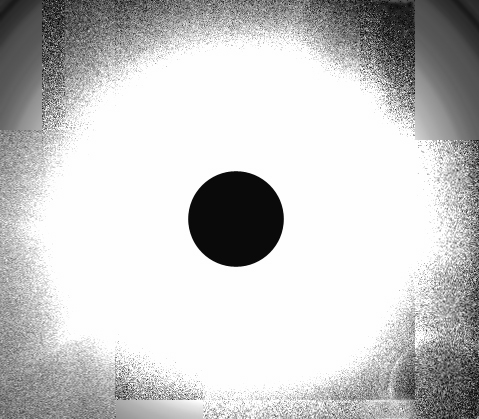
EXTENT OF THE CORONA
Glenn Schneider, University of Arizona
Jay Pasachoff & Steve Souza, Williams College
CALIBRATION NOTES
Subsequent to the initial web posting regarding these data, the individual 40ms integration CCD frames taken on the flight deck gyro platform of QF 2901 with an SBIG ST2000XM CCD, have been instrumentally calibrated. Each of the frames had subtracted from them a dark/bias reference frame (made from a median combination of 25 dark/bias frames taken on the aircraft just prior to the eclipse imaging sequence), and were fat fielded as well (see Post Processing for a note on flat fielding). A wide-field image mosaic created from the calibrated offset pointed frames (as previously discussed) and is shown here in several forms.
NOTE: ALL images on or linked from this page are produced at 1/4 the original pixilization to facilitate web-based display. The original CCD matrix BEFORE enlarging the image composite by combining offset pointed fields (see above) was 1600x1200 pixels. Any discussion related to "pixels" here is in the 1/4-size (1/16 array) resampled pixel space unless otherwise noted.
IMAGE DEPTH and RADIAL EXTENT
How deep did we go? This is illustrated in a linear display of the final wide-field mosaic in a linear display stretch to show the full radial extent of the corona. In this hard stretch at the bottom of the dynamic range, little information is conveyed about the structure within the corona.

EXTENT OF THE CORONA
We imaged the corona to a distance of at least 6 Solar radii from the heliocenter (see the radial profile below). Indeed, at an even harder stretch than shown above, one can still see declining isophotes at the edge of the mosaiced field. At such a hard stretch the Moon appears. At this extreme level of displayed surface brightness the limb of the Moon would be diffused by scattered light. As a visualization aid, the inset dark circle is a mask which is 2% larger than the apparent (mean) lunar angular diameter. During the imaging sequence, from which this image mosaic/composite was made, the Moon was moving across the sun, so this mask fully contains its displaced position with respect to the Sun over that time. In instrumental units, this image is displayed at a stretch from 0 to 100 counts, where the median surface brightness of the inner corona immediately adjacent to the occulted photosphere was measured at 100,000 counts.
LINEAR DISPLAYS
It is impossible to capture the full extent of the dynamic range of
the solar corona recorded on the QF2901 flight deck CCD imager in a single
linear image display image display. Indeed about 10 are needed given
the appx. 1/4% stepped intensity display depths (per channel) on most computer
monitors. Indeed, about 10 images are needed, as shown in the QuickTime
movie, prepared earlier with the data still in uncalibrated form.
DISPLAY TRANSFORMATIONS & RADIAL SURFACE BRIGHTNESS ("GRADIENT") FILTERING
An effective way to collapse the dynamic display range is to perform a non-linear numerical transformation on the data. In doing so, however, as the image contrast in any given radial zone (which declines outward from the Sun) is also collapsed. Hence, in any given radial zone the structural features in the corona are not as apparent as in a linear display specifically optimized in display stretch for the surface brightness of that zone. To mitigate this (to various degrees) one can subtract the underlying radial brightness profile of the corona before displaying the image, which then improves the image contrast for features such as coronal streamers, holes, etc. Most image editing programs, such as Photoshop, provide "features" for "radial gradient" masking. However, one cannot specify the quantitative form of the radial mask, and if not properly matched to the data themselves, zonal artifacts are introduces. Additionally, but subjectively, radial gradient masking is often done with too heavy a hand, which results in a coronal with very star image contrasts in its internal features, which for esthetics (rather than photometric) purposes is often displeasing.
A proper radial gradient filter should be made from the data themselves.
I do this by computing the median radial surface brightness profile, in
1 pixel wide annular zones, and then very modestly smoothing the profile
(with a 2 pixel boxcar) to reduce the effect of any anomalously bright
or dark zones due to uncompensated pixel defects. In the case of
the above image, here is the radial surface brightness profile, expressed
as a median per-pixel intensity with respect to a median pixel the brightest
circum-solar zone in a log (base 10) plot:
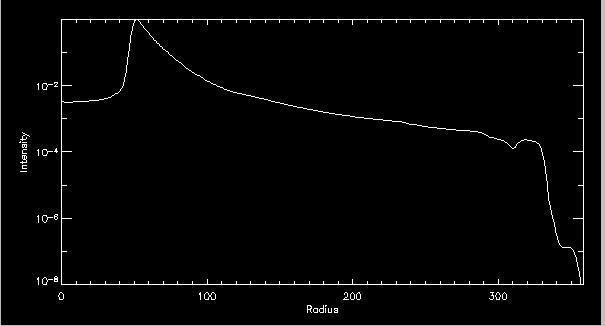
CORONAL SURFACE BRIGHTNESS PROFILE (self-normalized)
As you can see we imaged the corona very well (at high S/N) out to a distance of 300 (1/4 size resampled) image pixels. The angular radius of the Sun is appx. 45 image pixels (hence agreeing with the earlier statement "we imaged the corona to a distance of at least 6 Solar radii from the heliocenter". The sharp drop-off beyond the R ~ 300 pixel region is where the data become both photon starved and field size constrained.
In subtracting a MEDIAN radial profile one must take care not to locally oversubtract. With this data set subtracting more than 30% of the profile intensity begins to "dig holes" in the image where it is brightest - in the inner corona adjacent to the lunar limb (you can see the rising power in the surface brightness profile at small radii near the limb). Being very conservative, so that no negative residuals arise at any radial zones, images were produces subtracting 20% of the profile. These are shown, first, in square root displays.
SQUARE ROOT DISPLAYS
Displaying the square root of the data, after 20% radial profile subtraction,
allow showing most of the coronal dynamic range in only three images as
illustrated below:
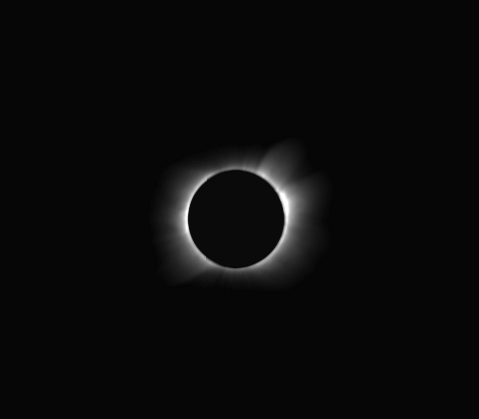 |
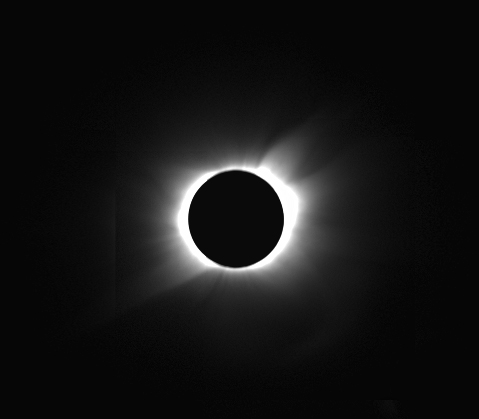 |
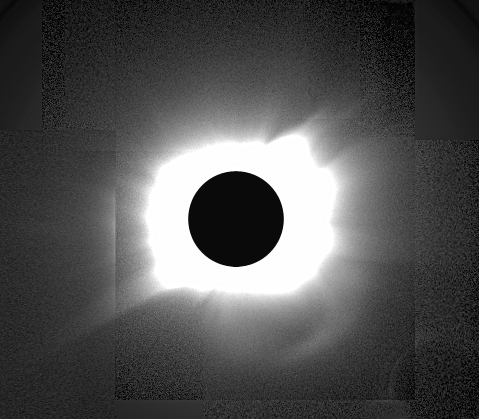 |
Note the extent and structure of the coronal streamers beyond the region, in each display, beyond where the display is saturated. The vertical and horizontal lines are artifacts of imperfect flat-fielding in combining the image data taken with different field pointings. The flat-field illumination source used to ascertain the inter-pixel CCD response may not have been intrinsically uniform (see Flat Field discussion), which makes photometric calibration at the lowest signal levels difficult (if not impossible). The brighter diffuse arc, are below the sun and to right at about 3 solar radii from the heliocenter, is an artifact due to an afocal image ghost, likely from a multiple reflection off the aircraft window.
LOGARITHMIC DISPLAYS
To further collapse the radial dynamic range in the image display a logarithmic transformation can be applied. (Here I use log base 10, which makes it easy to keep track of transformed intensities, but any logarithmic base can be used as desired). Such a display will result in a slightly contrast in specific radial zones, but does indeed show the global structure of the coronal at a glance.
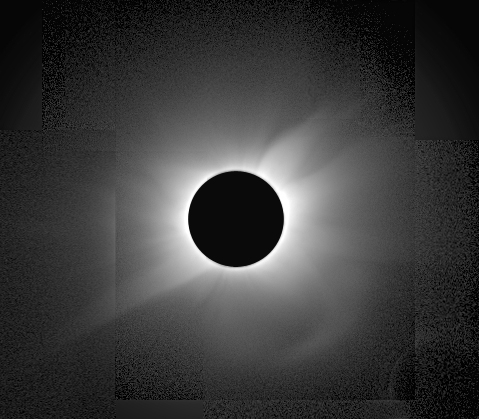
LOGARITHMIC DISPLAY
To he image above is displayed over [3.8] dex after subtracting 20% of the radial brightness profile - a dynamic range of appx 6,300. Contrasts "improvements" can be had at the expense of saturating he display in the center, clipping the extent of the corona at large radii, or introducing a small level of negative residuals by a modest oversubtraction of the radial surface brightness profile.
CONTRAST ENHANCEMENT
Moderate contrast improvement over most of the radial range, at the expense of the introduction of some quantization noise at large distance, may be had by taking the product of the above two transformations, and displaying the product itself in a logarithmic stretch. For these data, first subtraction a 30% profile is warranted (and supported by the data) as it results in only a very small local region of oversubtraction - which sharp eyed observers will see as a few "extra" dark pixels in the following image just at the bottom of the 2% oversized lunar mask:
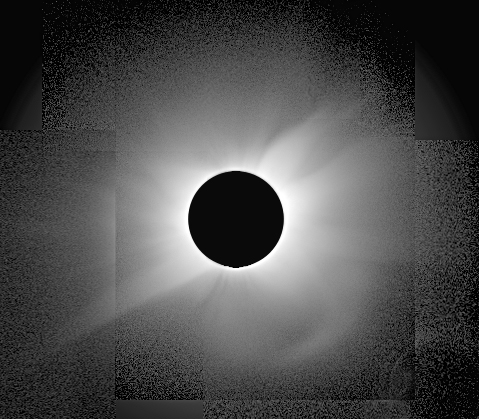
FLAT-FIELD ERRORS, IMAGE MOSAICS, and SPATIAL FILTERING
The above image mosaic is not "seamless". This is primarily a result of residual photometric errors in the attempted flat-field compensation. The flat field calibration frames (from which a calibration reference file was made and applied to the individual eclipse images) were obtained prior to shipment of the equipment to Australia/Antarctica by Steve Souza (Williams College). While these frames taken with the optical system (lens and filter) in place and exposed on a uniformly illuminated target, these were not sky flats, and hence not at infinity. Examination of the flatted image data obtained from the eclipse, at different field pointings, indicates residual large-scale (global) flat-field errors. These are likely due to focus-dependent vignetting in the optical system, pointing-dependent diffuse stray light scattered/reflected from the aircraft window, or a combination of both. Empirical corrections to the differential flat-field errors were assessed from the image-overlap areas in the ensemble of offset-pointed target frames. These corrections were then applied to the image mosaic which, for the most part, removed the differential flat-field errors. These errors, before correction, are most severe on frame boundaries both because of detector edge defects, and very different S/N across over-lap boundaries because of the small number of frames. Corrections to rows and columns along the boundaries themselves, works best by assessing the needed corrections after performing a mild gradient-edge enhancement to the images. This process (subtracting a fraction of the local median about every pixel) is similar to "unsharp masking". When properly controlled this process also spatially filters the image to bring out higher spatial frequency information in the corona, but at the modest expense of accentuating the pixel-to-pixel noise in the low S/N regions of the image. The result, with some subjectivity in tuning parameters, is shown below, and except for some further subjectivity in how to present the data (contrast, spatial filter bandwidth, dynamic range clipping, etc.) this is very likely about the "best" which can be obtained from these data (and, it makes a pretty nice picture!):
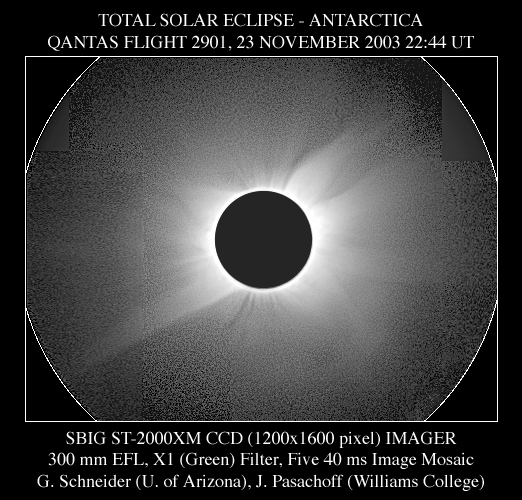
"Final"* Wide-Feild Mosaic Image of TSE 2003 from
QF 2901
* it's never really final, of course...
Two notes:
1) This above flat-field error compensation process worked very well in an intra-field and inter-frame sense (as the image above demonstrates). Bringing frame 11_04 (lower left) under control was much more difficult, and uncompensated systematic can still be seen - though at a very low level.
2) The surface brightness excess in the region of the previously noted afocal image ghost (at 3 R(sun) to the lower right) was assessed in comparison to the median surface brightness at the same radial zones, excluding this contaminated sector. This excess was then "removed" (by intensity scaled subtraction) from each pixel whose intensity exceeded by 3-sigma the azimuthal median at the same radius. The intensity subtracted was the fraction of the intensity at that point in 3-sigma excess. This, too, is imperfect, but is a marked improvement.
NOTE: ALL images here are produced at 1/4 the original pixilization to facilitate web-based display. The original CCD matrix BEFORE enlarging the image composite by combining offset pointed fields (see above) was 1600x1200 pixels. Any discussion related to "pixels" here is in the 1/4-size (1/16 array) resampled pixel space unless otherwise noted.
SOHO/LASCO L2, QF 2901 & SOHO/EIT
The LASCO (Large Angle Spectrometric coronagraph) L2 Coronagraph, and the EIT (Extreme-Ultraviolet Imaging Telescope) on NASA's SOHO spacecraft were imaging the solar coronal and photosphere, respectively, at times very close (and during) the eclipse. Our QF 2901 Flight Deck imager, during totality, covered an inner radial region which cannot be reached by this space-based facility. An image composite of outer corona with SOHO/LASCO L2, mid and inner corona from QF 2901, and the photosphere with SOHO/EIT, all nearly contemporaneous, is shown below.
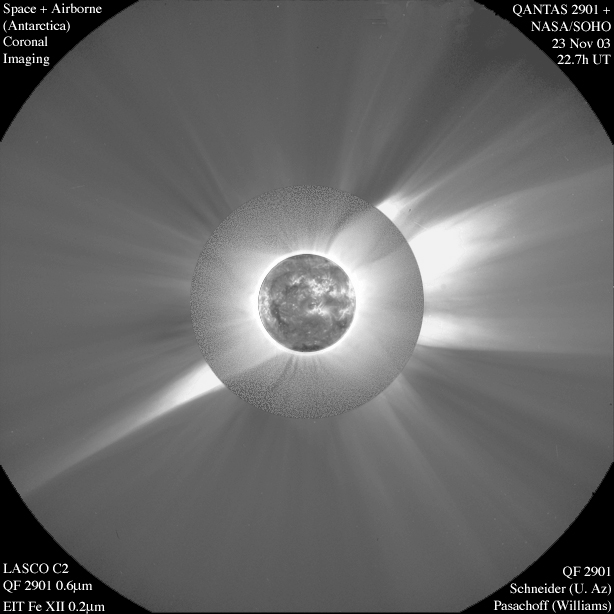
QF 2901 (Airborne) + SOHO (Space) Imaging of TSE 2003
(Alternate representations: QF
2901 clipped, QF 2901 smoothed)
The LASCO C2 image was prepared (by the SOHO project) independently from the QF 2901 image, and was provided in non-quantitative form (as a JPEG file) with its brightest regions hard-stretched to white, and with a linearity transfer which differs from the QF 2901 processed image. Hence, the "boundary" between the two images appears somewhat discontinuous in local intensity and in their radial brightness gradients, but is presented in this form to illustrate the morphology of the coronal structures from the photosphere outward. With the actual LASCO C2 data, which we are requesting, we should be able to re-present this equitably for both data sets. In addition, because there is a region of overlap in the LASCO C2 and QF 2901 imagery, we should be able to cross-calibrate the two data sets and obtain an absolute radiometric calibration (subject to filter band transfer uncertainties) of the entire corona. Stay tuned.
Return to Glenn Schneider's
Home Page